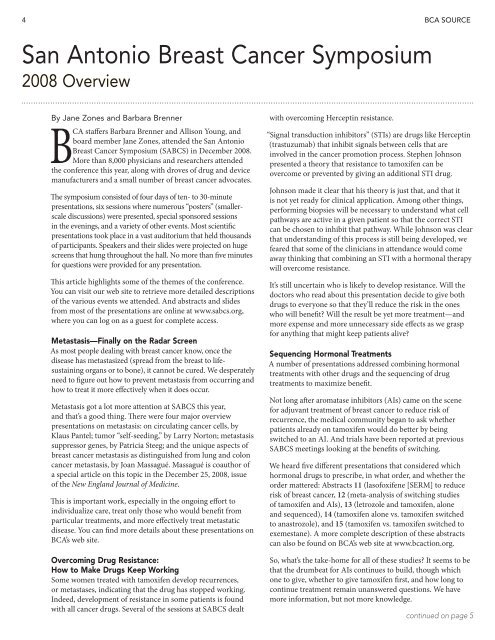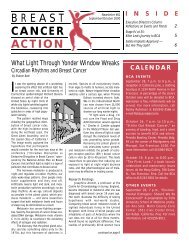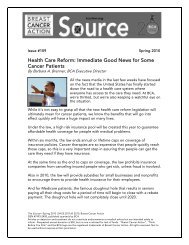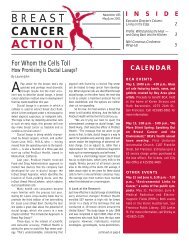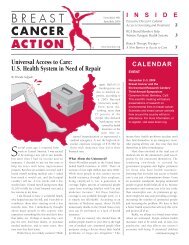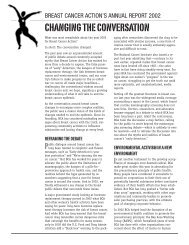Old Evil, New Twist - Return to Home Page - Breast Cancer Action
Old Evil, New Twist - Return to Home Page - Breast Cancer Action
Old Evil, New Twist - Return to Home Page - Breast Cancer Action
- No tags were found...
You also want an ePaper? Increase the reach of your titles
YUMPU automatically turns print PDFs into web optimized ePapers that Google loves.
4 San An<strong>to</strong>nio <strong>Breast</strong> <strong>Cancer</strong> Symposium2008 OverviewBy Jane Zones and Barbara BrennerBCA staffers Barbara Brenner and Allison Young, andboard member Jane Zones, attended the San An<strong>to</strong>nio<strong>Breast</strong> <strong>Cancer</strong> Symposium (SABCS) in December 2008.More than 8,000 physicians and researchers attendedthe conference this year, along with droves of drug and devicemanufacturers and a small number of breast cancer advocates.The symposium consisted of four days of ten- <strong>to</strong> 30-minutepresentations, six sessions where numerous “posters” (smallerscalediscussions) were presented, special sponsored sessionsin the evenings, and a variety of other events. Most scientificpresentations <strong>to</strong>ok place in a vast audi<strong>to</strong>rium that held thousandsof participants. Speakers and their slides were projected on hugescreens that hung throughout the hall. No more than five minutesfor questions were provided for any presentation.This article highlights some of the themes of the conference.You can visit our web site <strong>to</strong> retrieve more detailed descriptionsof the various events we attended. And abstracts and slidesfrom most of the presentations are online at www.sabcs.org,where you can log on as a guest for complete access.Metastasis—Finally on the Radar ScreenAs most people dealing with breast cancer know, once thedisease has metastasized (spread from the breast <strong>to</strong> lifesustainingorgans or <strong>to</strong> bone), it cannot be cured. We desperatelyneed <strong>to</strong> figure out how <strong>to</strong> prevent metastasis from occurring andhow <strong>to</strong> treat it more effectively when it does occur.Metastasis got a lot more attention at SABCS this year,and that’s a good thing. There were four major overviewpresentations on metastasis: on circulating cancer cells, byKlaus Pantel; tumor “self-seeding,” by Larry Nor<strong>to</strong>n; metastasissuppressor genes, by Patricia Steeg; and the unique aspects ofbreast cancer metastasis as distinguished from lung and coloncancer metastasis, by Joan Massagué. Massagué is coauthor ofa special article on this <strong>to</strong>pic in the December 25, 2008, issueof the <strong>New</strong> England Journal of Medicine.This is important work, especially in the ongoing effort <strong>to</strong>individualize care, treat only those who would benefit fromparticular treatments, and more effectively treat metastaticdisease. You can find more details about these presentations onBCA’s web site.Overcoming Drug Resistance:How <strong>to</strong> Make Drugs Keep WorkingSome women treated with tamoxifen develop recurrences,or metastases, indicating that the drug has s<strong>to</strong>pped working.Indeed, development of resistance in some patients is foundwith all cancer drugs. Several of the sessions at SABCS dealtwith overcoming Herceptin resistance.“Signal transduction inhibi<strong>to</strong>rs” (STIs) are drugs like Herceptin(trastuzumab) that inhibit signals between cells that areinvolved in the cancer promotion process. Stephen Johnsonpresented a theory that resistance <strong>to</strong> tamoxifen can beovercome or prevented by giving an additional STI drug.Johnson made it clear that his theory is just that, and that itis not yet ready for clinical application. Among other things,performing biopsies will be necessary <strong>to</strong> understand what cellpathways are active in a given patient so that the correct STIcan be chosen <strong>to</strong> inhibit that pathway. While Johnson was clearthat understanding of this process is still being developed, wefeared that some of the clinicians in attendance would comeaway thinking that combining an STI with a hormonal therapywill overcome resistance.It’s still uncertain who is likely <strong>to</strong> develop resistance. Will thedoc<strong>to</strong>rs who read about this presentation decide <strong>to</strong> give bothdrugs <strong>to</strong> everyone so that they’ll reduce the risk in the oneswho will benefit? Will the result be yet more treatment—andmore expense and more unnecessary side effects as we graspfor anything that might keep patients alive?Sequencing Hormonal TreatmentsA number of presentations addressed combining hormonaltreatments with other drugs and the sequencing of drugtreatments <strong>to</strong> maximize benefit.Not long after aromatase inhibi<strong>to</strong>rs (AIs) came on the scenefor adjuvant treatment of breast cancer <strong>to</strong> reduce risk ofrecurrence, the medical community began <strong>to</strong> ask whetherpatients already on tamoxifen would do better by beingswitched <strong>to</strong> an AI. And trials have been reported at previousSABCS meetings looking at the benefits of switching.We heard five different presentations that considered whichhormonal drugs <strong>to</strong> prescribe, in what order, and whether theorder mattered: Abstracts 11 (lasofoxifene [SERM] <strong>to</strong> reducerisk of breast cancer, 12 (meta-analysis of switching studiesof tamoxifen and AIs), 13 (letrozole and tamoxifen, aloneand sequenced), 14 (tamoxifen alone vs. tamoxifen switched<strong>to</strong> anastrozole), and 15 (tamoxifen vs. tamoxifen switched <strong>to</strong>exemestane). A more complete description of these abstractscan also be found on BCA’s web site at www.bcaction.org.So, what’s the take-home for all of these studies? It seems <strong>to</strong> bethat the drumbeat for AIs continues <strong>to</strong> build, though whichone <strong>to</strong> give, whether <strong>to</strong> give tamoxifen first, and how long <strong>to</strong>continue treatment remain unanswered questions. We havemore information, but not more knowledge.continued on page 5


